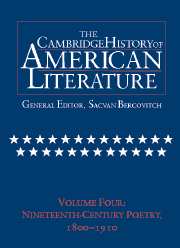Book contents
- Frontmatter
- Introduction
- AMERICAN VERSE TRADITIONS, 1800–1855
- POETRY AND PUBLIC DISCOURSE, 1820–1910
- Preface: the claims of rhetoric
- 1 Modest claims
- 2 Claiming the bible
- 3 Poetic languages
- 4 Plural identities
- 5 Walt Whitman: the office of the poet
- 6 Emily Dickinson: the violence of the imagination
- Chronology, 1800–1910
- Bibliography
- Index
6 - Emily Dickinson: the violence of the imagination
from POETRY AND PUBLIC DISCOURSE, 1820–1910
Published online by Cambridge University Press: 28 March 2008
- Frontmatter
- Introduction
- AMERICAN VERSE TRADITIONS, 1800–1855
- POETRY AND PUBLIC DISCOURSE, 1820–1910
- Preface: the claims of rhetoric
- 1 Modest claims
- 2 Claiming the bible
- 3 Poetic languages
- 4 Plural identities
- 5 Walt Whitman: the office of the poet
- 6 Emily Dickinson: the violence of the imagination
- Chronology, 1800–1910
- Bibliography
- Index
Summary
FEMININE FIGURES: IN CRITIQUE OF AMERICAN SELFHOOD
Emily Dickinson seems in many ways at the furthest remove from Walt Whitman. His inclusive, expansive energy poses the most extreme counterpoint to Dickinson's exclusions, retractions, and renunciations. Dickinson's work, however, addresses cultural forces and challenges in ways continuous with Whitman's, although ultimately with a difference in cultural position from his which remains fundamental.
Dickinson's placement in terms of wider cultural concerns has been complicated by a privacy so fine no event seems able to penetrate it. Both as woman and poet, Dickinson seems intractably a figure of isolation. Her biographical seclusion cut her off from direct social intercourse with her surrounding world. Her texts seem to draw a circle around themselves, in momentary and apparently inconsistent expression. Even phrases or words are fragmented and isolated by her idiosyncratic dashes, which substitute for the integrating medium of punctuation. All of these almost compel an image of Dickinson's as a private and autonomous, if also a provisional and fragmentary world.
But Dickinson's work nonetheless reflects and enacts cultural forces and cultural challenges. A resistance to history is certainly suggested by her own severe textual obliqueness, as well as by her riveting refusal either to appear in public or to allow the publication of her work. In another sense, however, Dickinson's texts are scenes of cultural crossroad, situated within and acting as an arena for the many and profound transitions taking place around her. This apparent contradiction between private and public involvements is indeed itself a cultural one. Dickinson, among other things, brings to a kind of great consummation – and also transformation – a developing tradition of nineteenth-century women's writing, in which just such tensions between private and public loom large.
- Type
- Chapter
- Information
- The Cambridge History of American Literature , pp. 427 - 480Publisher: Cambridge University PressPrint publication year: 2004



